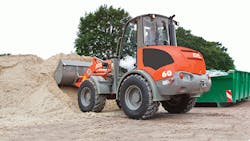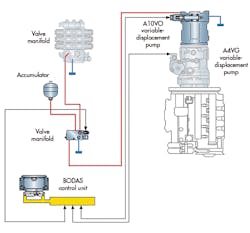Automatic start-stop systems conserve fuel by shutting off the engine when it’s not needed. This technology has now found its way into wheel loaders — with a reduction in fuel consumption by as much as 30%.
At Atlas Weyhausen, we have been working on a hybrid drive for wheel loaders in the 6-ton category since mid-2006. Our target was to lower fuel consumption, since it is not exactly easy to fulfill soot emission regulations. Smaller wheel loaders operate only intermittently, which means that most of the time the diesel engine is running at partial load and thus emits a comparatively high amount of soot. After just 16 hours, the soot filter was full and had to be replaced.
From the beginning of our development work, an evaluation of the loads revealed several points where a hybrid solution could relieve the engine. This primarily involves operations when the vehicle is at a standstill. It is no exaggeration to say that a wheel loader’s engine runs in neutral for up to 30% of its total working life—250 to 300 hr/yr—and consumes an unnecessary amount of fuel while doing so. An automatic start-stop system seemed to be a feasible way to achieve savings.
From electric hybrid to hydraulic
We first tried to design an electrically powered system. However, the components needed for this are not currently available on the market or do not meet our standards, including acceleration values of 16 G and more, temperatures ranging from –40° to +50° C, and extremely high dust levels. These are all physical loads with which no battery can cope.
That was why we soon concentrated our efforts on developing an automatic start-stop system based on hydraulics. The innovative thing about this system is that the hydraulic pump for the implements, which is already a part of the unit, also charges an accumulator that delivers the energy required to restart the engine using a hydraulic starter motor.
This file type includes high resolution graphics and schematics when applicable.
Tried-and-tested hydraulic components
As a medium-sized company, we sought to utilize the core competence of a single partner when developing the hydraulics for the wheel loader. As we had already decided to use Rexroth drive pumps, drive motors, and a steering gear modified especially for us, it seemed only logical to work with Rexroth on the automatic start-stop system as well.
The entire system, in our preliminary model called the AR 60 start-stop, consists of a Rexroth A10VO pump, a BODAS control unit, an automatic start-stop valve manifold, and four reservoirs, each with a volume of 0.6 liters. This is a highly manageable package when compared to the electrical solution.
Space plays an important role in a compact wheel loader. It is far from easy to find room for additional equipment. We used to fit a 23-cm³ gear pump to power the implements. For the automatic start-stop system, we will be using a 45-cm³ variable-displacement pump capable of pressure to 280 bar. We ascertained in our CAD analyses that it would fit nicely into the engine compartment without modification, even though it is a relatively large unit.
The accumulators, on the other hand, were easy to deal with because we were able to fit them underneath the cab. Accumulators do not have to be easily accessible for maintenance, nor do they generate appreciable noise.
More about BODAS
BODAS is an electronic control system designed to meet a wide variety of requirements for mobile equipment. It has consistent modular architecture with matched interfaces to make it easy to integrate all components in building new systems or adding functionality to existing designs. The matching of the BODAS system to Rexroth hydraulics also increases the efficiency of the entire working machine.
Sensors, displays and joysticks round out the line of hardware modules. Thus, BODAS supplies all components for a complete electrohydraulic drive system from a single source. Complete solutions combining travel functions and working functions are optimally matched to one another.
Reliability — Programmable RC controllers are the heart of the BODAS hardware modules and ensure high reliability and availability of machines in spite of harsh mechanical demands, extreme environmental conditions, or strong electromagnetic disturbances.
Flexibility — As with the hardware, the BODAS software is modularly structured. Preconfigured software modules are matched to one another and configured by the user or can be customized to an application. Programs can be created using either BODAS-design according to standard IEC61131-3. Multiple controllers can be connected via CANbus to form a network. Safety features integrated in the standard version enable simple and reliable machine diagnostics.
Tools — BODAS-design is a development environment for the comfortable programming of BODAS controllers. Additional tools provide assistance while performing simulations or diagnostics during the optimization of the entire machine control. Development documentation is generated automatically to quickly and efficiently create application software for BODAS controllers. The BODAS C-API (C application interface) supplies predefined controller functions in a library that can be used for transferring the programs written in C to BODAS controllers.
For more information, go to Bosch Rexroth.
From zero to 2,200
As simple as the system architecture may appear, it was a challenging job to adapt it to our requirements. The wheel loader was to accelerate from zero to the maximum of 2,200 rpm quicker than from idling speed. We can now manage this within the 800 msec we previously needed to accelerate from idling to 800 rpm. We achieve this by using the energy stored in the accumulator, which kicks the diesel engine with a torque of some 180 N-m.
In this way the wheel loader operator can work comfortably and efficiently, conserve fuel, and help protect the environment. Once the wheel loader comes to a stop, the engine automatically cuts out after a period that can be preset as desired. If the operator turns the steering wheel or touches the joystick or the accelerator pedal, then the engine rapidly comes back to life. We also installed a seat sensor, so the system will only work if the driver is sitting in the cab—not outside.
Development focus on controls and engine
We had—and still have—to master complex challenges with the help of our partners in order to fulfill the requirements. The biggest one was the hydraulic controls. All the components have to interact perfectly to make sure the controls accomplish their desired functions within such short time intervals. The engine, pump, and valve manifold all have to communicate with each other.
The second challenge is the diesel engine itself—it has to be able to accept the high starting torque. We are currently working with Deutz to design the engine so that it can cope with 150,000 automatic starts and stops—which, after all, means tripling the 50,000 start operations originally specified.
As we are entering uncharted territories, with the automatic start-stop system we had—and still have—to find all the right answers ourselves, working in conjunction with our partners. Consequently, additional development work is necessary.
Less fuel, lower operating costs
But the efforts we have made are already bearing fruit. The benefits of the system speak for themselves. We can use existing hydraulic components with which we have already had good experience in terms of reliability and sturdiness—even though endurance testing still has to be completed.
The automatic start-stop system has also successfully helped us to reach our goal: to reduce fuel consumption. Almost 2,000 liters of diesel can be saved over the vehicle’s expected life span.
We were also able to improve on occupational health and safety. Neither soot nor noise is generated while the engine is off. This is a great advantage not only for the operator, but also when working in highly developed areas. What’s more, the system reduces operating costs because the wheel loader requires fewer operating hours operating to achieve the same results.
The next steps toward cost savings
However, not all the potential savings have been realized. The main pump is now twice as big as the previous one. This means we could reduce the diesel’s speed and still maintain the lifting gear’s operating speed. We call this “EcoWork.” Fuel consumption could be reduced by an additional 12% to 14%. Furthermore, Rexroth’s existing hydraulic systems hold additional opportunities for savings with just a few modifications: engine braking, booster systems, and more. Automatic start-stop is just the first step for us. In the initial development stages, we wanted to incorporate all these features, all at once—but that was just asking too much. In this respect, we are most grateful for the fact that the hydraulic system is scalable.
Artur Gabriel is development manager, Atlas Weyhausen GmbH, Wildehausen, Germany. For more information, visit www.atlas-weycor.de.
This file type includes high resolution graphics and schematics when applicable.
About the Author

Leaders relevant to this article:


